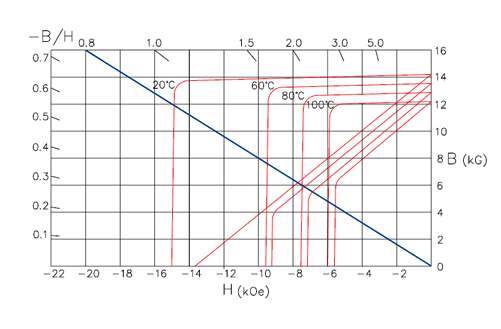..to your best source for incredibly strong neodymium rare earth magnets. If you are new to our site, we're glad you found us. We hope we can fill all of your neodymium rare earth magnet needs.
Demagnetization of Permanent Magnets
15/03/2014
A permanent magnet can lose some or all of its magnetic field under certain circumstances. When a permanent magnet is magnetized, its magnetic domains are aligned. Certain conditions can cause the domains to lose this alignment; thereby aligning randomly. This will cause the magnet to either have lost some or all of its magnetic field.
Thermal demagnetization
The primary method for deliberately de-magnetizing magnets is by heating them. Every magnetic material has a characteristic temperature known as the Curie Temperature. At this temperature the thermal agitations apply more force than the resistance of the magnetic domains to movement and the domains of the magnet randomize. After the material reaches the Curie temperature throughout its bulk, it will show virtually no net magnetization, and can be treated as virgin material.
In the case of samarium-cobalt permanent magnets, there is an additional factor to consider. The Curie temperature of most samarium-cobalt magnets is on the order of 700-800°C (1300-1500°F). At these temperatures, the material itself will tend to break down magnetically. After this process, the material's performance will be significantly degraded. Therefore, it is generally considered impractical to de-magnetize samarium-cobalt magnets.
Magnetic field effects
A magnet can be partially demagnetized based on the magnetic load placed upon it. This effect is normally studied by looking at the second quadrant of the hysteresis curve of the magnetic material, also referred to as the demagnetization curve. Typically, this is the only section of the hysteresis curve that is reported for a hard magnetic material. This curve shows the response of the magnets delivered flux into the space around it (B) to the demagnetizing force (H) imposed on the magnet. To assess the performance of the magnet material in a given situation, the user should calculate the ratio of B/H (taking care to ensure the conformity of units). Once this ratio is calculated a line is superimposed on the demagnetization curve, as below for a B/H ratio of 0.8 (note that the illustration shows four demagnetization curves to reflect different operating temperatures):
The curve of interest that we are comparing our blue line to is the diagonal red line, the demagnetization curve. Notice that each of the diagonal lines has a bend in it, colloquially referred to as the "knee" in the curve. If the blue line, which shows the working condition of the magnet crosses above the knee in the curve, then the magnet is operating in its safe linear region and should perform as expected. If the magnet's load line is below the knee on the curve, the magnet will become demagnetized and damaged. It is also important to notice that the knee gets higher with increasing temperatures, which reflects the material's increasing vulnerability to demagnetization at higher T.

 specialized in manufacturing all kinds of
specialized in manufacturing all kinds of